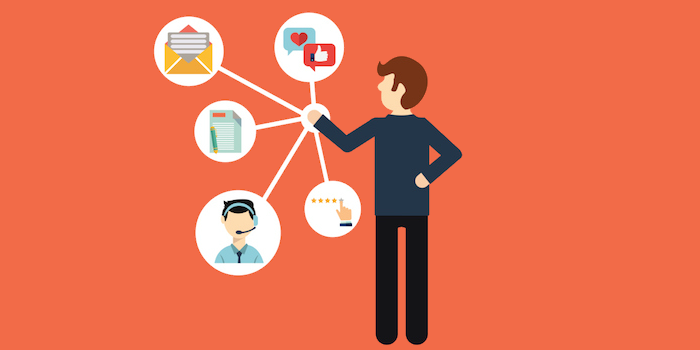Something’s changing — a powerful movement where all businesses, large and small, are shifting focus. Instead of prioritizing acquisition and burning through new customers, businesses are engaging with current customers, improving the customer experience, and successfully increasing repeat business. How? By making loyalty marketing a focal point.
This has become a big year for loyalty marketing developments. American Express recently introduced America’s first “coalition” loyalty program with the launch and heavy promotion of Plenti. Participants include leading retailers like Macy’s, Rite-Aid, AT&T, and Exxon. In the last few months, fast food mogul, Taco Bell announced its adoption of a loyalty program for the very first time, as did casual-dining chains, P.F. Changs and Chili’s.
Apple also announced at its recent developer conference support for loyalty cards in its Apple Pay product for merchants with strong loyalty programs like Dunkin Donuts, Panera Bread, JC Penney, and Kohl’s.
In addition, Street Fight magazine recently revealed internal research showing that some small business categories like restaurants, are more focused on keeping current customers versus acquiring new ones.
What’s driving this movement towards customer retention and away from acquisition? Clearly large and small businesses think loyalty marketing programs work and are worth building, but why? In this post, I shed some light on how and why loyalty marketing really works:
Download our free customer loyalty success guide to learn how to drive customers back 2x more.
Implementing “Smart Loyalty” versus “Basic Loyalty”
There are common misconceptions about loyalty marketing, such as the idea that it’s just about giving away rewards and discounts, which cuts into profit margins. Another misconception is that giving away rewards and points via a basic punch card program is enough to get return from loyalty marketing. These misconceptions result in the practice of “basic” loyalty marketing strategies.
Four years ago, when we first launched Fivestars, one of the first customer retention loyalty marketing programs built for local businesses, we also only used to offer “basic” loyalty strategies — simple points and rewards systems. However, “smart” loyalty marketing means gathering information about your customers, building relationships, and communicating the right messages to the right customers at the right times. It’s about the ability to personalize experiences both in and out of the store.
While loyalty marketing begins with points and rewards to build your database, this is only scratching the surface for what a robust customer retention marketing strategy can deliver.
We learned this lesson quickly and built our product to include tools to promote “smart” loyalty practices, such as analytics, customer segmentation, win-back campaigns, communication tools, and more.
Driving Additional Revenue
So how exactly do “smart” loyalty strategies drive revenue? When implemented well, they do the following:
- Increase visit frequency
- Increase spend per visit
- Increase win-backs from “lost” customers
1. Increase Visit Frequency
Let’s suppose your regular customers come into your store twice per week. Increasing visit frequency involves getting them to increase their visits to three times per week. How can you do this? The power of an attractive points and rewards structure, as well as what we call frequency compression.
Attain Frequency Compression
Frequency compression is the phenomenon where customers come in more frequently because they’re close to gaining a reward. Take frequent flyer programs for example. People are often semi-close to achieving an elusive “status” level on an airline they fly with regularly. The closer they get to that status, the more often they make choices like flying with that particular airline, even if it’s slightly more expensive than another.
We’ve graphed this phenomenon across our own Fivestars merchant base. Most of our merchants offer a reward or discount after ten visits, so we monitored Fivestars users who were close to visiting certain stores at least ten times. Sure enough, the closer they got to their free reward, the more frequent their visits became. It’s quite amazing to see.
How do you drive frequency compression for your customers? You want a points and rewards system, and your members should always know how close they are to attaining their next reward. You also want to encourage visits during times when people aren’t anywhere near their next reward. This in turn moves people even closer to that reward, which increases visits. You do this through consistent communication and individual promotions.
A robust rewards program should get regular customers back in the door 20% more often. Since regulars drive 80% of your revenue, the impact of a 20 percent lift in visit frequency could be quite substantial.
2. Increase Spend Per Visits
Say you’re a sandwich shop and typically get about $10 per transaction. How do you increase each transaction to at least $11 per visit? By implementing “smart” loyalty marketing strategies, such as rewarding customers with points based off of dollars spent.
Let’s go back to the airline miles example. Since I know spending money on my airline of choice gives me points towards free tickets and benefits like being able to board earlier, I’m willing to spend slightly more for my tickets with that specific airline. Can you increase your prices slightly after you implement an attractive rewards program? It’s possible if your rewards program is set up properly. Typically, we see spend per visit increase by 10 to 25% after implementing a simple and attractive rewards program based on spend or items purchased.
3. Increase Win-backs from Lost Customers
Smart loyalty marketing strategies also drive revenue by winning back lost, inactive customers.
In general, more than 50% of customers don’t return to restaurant after the first visit. Also, for each month that passes after a customer’s first visit, the probability of that customer coming back generally declines—sometimes by up to 50 percent. Why does this happen? Because customers usually have a plethora of other places to go. Even if they had a great experience with your business, as time passes, their memory of it fades.
How do you win back lost customers? Consistent communication, and “win-back” campaigns, which keep your business top of mind.
This starts by building up your loyalty program membership database, collecting members’ contact info at the point of sign up, and staying in touch with them often. Then, you implement “smart” loyalty marketing strategies, such as segmenting your membership database based on last visit date, and sending targeted (preferably automated) messages and promotions. These “win-back” campaigns are key to gaining back lost customers.
If certain customers haven’t been back in 30, 60, 90 days, send them various promotions, remind them of your existence, tell them you value their business, and reward them for coming back.
Our merchants have seen 10% of lost customers return by sending targeted messages, and merchants who consistently communicate through top-notch promotions sometimes see up to a 70% lift in store visits.
Turning Transactions into Relationships
Successful loyalty marketing also involves building relationships with your customers. This is becoming increasingly possible with the proliferation of customer loyalty technology.
Relationships happen through shared history. The more you get customers to come back (through your loyalty marketing efforts), the more history you have together, the more you can really get to know people as individuals and treat them as such. As this happens more frequently, the hope is that eventually businesses and their surrounding communities become more vibrant and truly thrive – The biggest return from loyalty marketing.
Investing in your own loyalty marketing program? Read up on these 4 things you should consider.






Leave a Comment